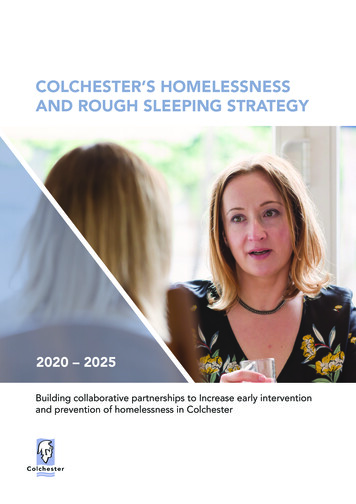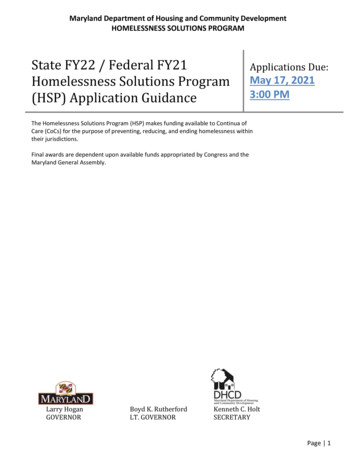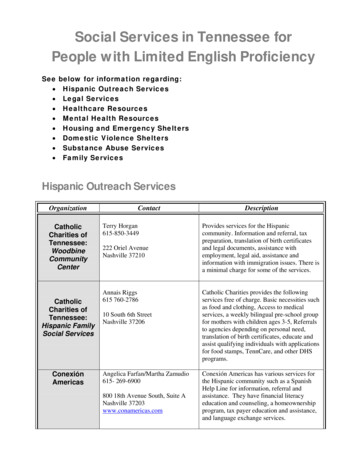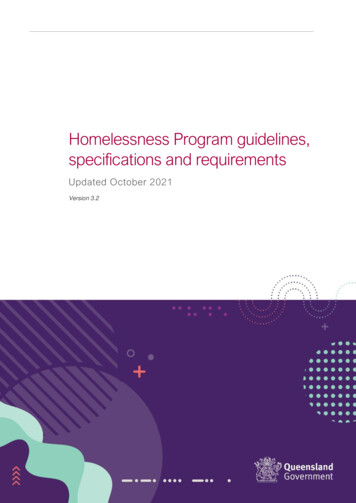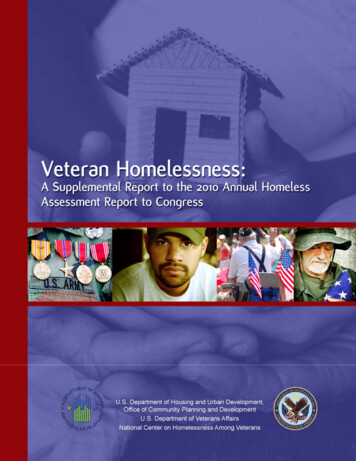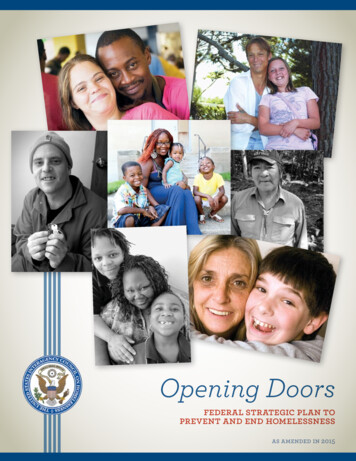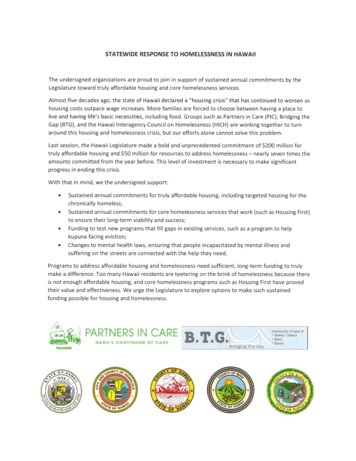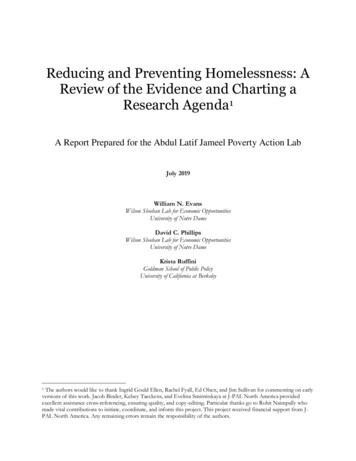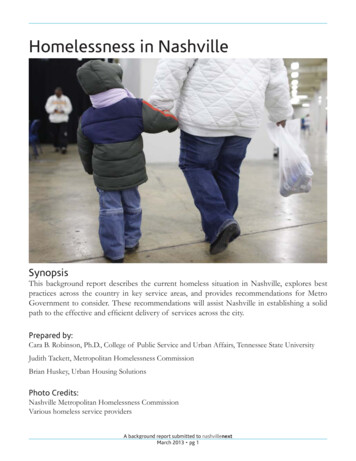
Transcription
Homelessness in NashvilleSynopsisThis background report describes the current homeless situation in Nashville, explores bestpractices across the country in key service areas, and provides recommendations for MetroGovernment to consider. These recommendations will assist Nashville in establishing a solidpath to the effective and efficient delivery of services across the city.Prepared by:Cara B. Robinson, Ph.D., College of Public Service and Urban Affairs, Tennessee State UniversityJudith Tackett, Metropolitan Homelessness CommissionBrian Huskey, Urban Housing SolutionsPhoto Credits:Nashville Metropolitan Homelessness CommissionVarious homeless service providersA background report submitted to nashvillenextMarch 2013 pg 1
HOMELESSNESSRole and Purpose of Background ReportsTThis background report was developed to provide inputto the NashvilleNext planning process. It was researchedand authored by community members interested, invvolved, and knowledgeable on the topic. The authorspresent best practices, an evaluation of the state of thetopic in the Nashville community today, and recommendations for consideration during the planning process.This report provides a starting point for broader community discussion and reflection based on the research and recommendations of the authors. Throughout theplanning process, NashvilleNext will use this and other background reports, ongoing research, departmental involvement, community input and engagement to discuss, refine and formulate the policies and recommendations for the general plan.The information and recommendations provided in this background report aresolely those of the authors and contributors and are being provided at the beginning of the NashvilleNext process to start community discussion.The NashvilleNext Steering Committee thanks and extends its sincere appreciation to the authors of and contributors to this background report for the time andeffort to provide this report for community consideration and discussion. TheSteering Committee looks forward to the ongoing dialogue on the issues and recommendations that the authors provide.Any final policies and recommendations endorsed by the NashvilleNext SteeringCommittee for the consideration of the Metropolitan Planning Commission willbe the result of the entire planning process and upcoming community engagementand discussion.A background report submitted to nashvillenextMarch 2013 pg 2
HOMELESSNESSTable of ContentsIntroduction4Nashville’s Homeless Estimates4Nashville’s Homeless Population6Nashville’s Agencies and Services7Nashville’s Cost of Homelessness8Nashville’s Main Funding Sources9Homelessness Best Practices11Homeless Prevention11Homeless Emergency Services11Homeless Supportive Services and Case Management12Homeless Long-Term Housing13Homeless Community Coordination13Recommendations and Ideas for Further Discussion15Resources and Further Reading16A background report submitted to nashvillenextMarch 2013 pg 3
HOMELESSNESSIntroductionOn any given night, 3,000 to 4,000 individuals andfamilies are homeless in Nashville. This number isthe best estimate that the Metropolitan Homelessness Commission currently has – but it is just that,an estimate. The estimate is based on point-in-timenumbers and service provider numbers collected bythe Metropolitan Development and Housing Agency(MDHA), annual numbers from the MetropolitanNashville Public School system, and observationsfrom outreach workers and people who serve theNashville homeless population.The following section provides an overview of howthe Commission derives at this estimated number,what populations are included in this number, whothe main agencies are providing services to Nashville’s homeless population, and what some of themain funding sources are for these services. This isfollowed by sections on best practices in providingservices for the homeless and recommendations forconsideration during the NashvilleNext planningprocess.TABLE 1:Point-in-Time Counts, NashvilleYearIn sheltersOn street /In 447227496390466398339360no 224*2,335* Total count for 2012 uses the “On street/In camps” count from 2011Nashville’s Homeless EstimatesThe U.S. Department of Housing and Urban Development (HUD) requires larger cities to collect dataon homelessness utilizing Point-in-Time Counts,Housing Inventory Counts, and Homeless Management Information Systems (HMIS).Nashville’s Point-in-Time counts people on one specific night during winter. Table 1 shows the countsbetween 2004 and 2013. It is important to note thatin 2012, only a shelter count was conducted, whichshowed 1,864 people stayed in shelters during thenight of the Point-in-Time Count.The outdoor numbers of the Point-in-Time Countheavily depend on outdoor temperatures, which canvary widely during the last ten days of January whenthe HUD-required Point-in-Time Count is normallyconducted. The Point-in-Time Count does not include people sleeping in motels, doubling up withfamily or friends, sleeping in cars or other locationsnot easily accessible to counters.The 2012 Housing Inventory shows a total of 2,941beds are made available by 26 service providers forNashville’s homeless population. These beds includetransitional housing (892), emergency housing (685)and permanent supportive housing opportunities(1,365). In addition, three beds are listed as rapid rehousing opportunities through Oasis Center, whichserves homeless youth. While the Housing Inventoryreports the bed availability, the number of permanentsupportive housing opportunities listed does not indicate the intensity and frequency of supportive services that are provided.With the advancement of computer technologies inthe 1990s, several academic researchers and policyleaders began to envision a coordinated system ofdata collection for homeless service delivery. Thiscoordinated system ideally links agencies, streamlines the registration process for clients while alsoproviding communities with longitudinal data aboutA background report submitted to nashvillenextMarch 2013 pg 4
HOMELESSNESSthe usage of services within their Continuums. Thelongitudinal data could help communities designsystems better suited to serve clients (i.e. pinpointing program gaps for subpopulations) and save costs(i.e. reducing duplication of services and maximizingcooperative efficiencies). However, HMIS numbersreflect the diligence in which service providers enter data. Nashville tried to create its own HMIS software application, but eventually decided to purchaseServicePoint by Bowman. Service providers startedto be trained on data entry in the fall of 2011. Currently, HMIS shows that 5,805 clients were served by16 service provider agencies during 2012. However,the 5,805-client number includes duplicates of clientswho were seen by more than one agency.At this point, data for the Nashville Rescue Mission, the largest local year-round emergency shelterprovider, have not been entered into HMIS yet. TheNashville Rescue Mission reports that between January 1, 2012, and November 20, 2012, it served a totalof 4,538 individuals. Of those individuals, 2,671 wereadult males, 224 were males under the age of 18, and1,643 were females.Moving forward, HMIS has great potential to createan overall picture of the homeless population inNashville. However, the quality of data depends onthe utilization rate of agencies and their willingness toshare information to achieve unduplicated numbers.Homelessness has many faces. The National Allianceto End Homelessness distinguishes between the following populations: Chronic HomelessnessFamiliesYouthVeteransRural HomelessnessDomestic ViolenceMental/Physical HealthPrisoner Re-EntryA background report submitted to nashvillenextMarch 2013 pg 5
HOMELESSNESSNashville’s Homeless PopulationChronic HomelessnessIn Nashville, it is estimated, based on observationthrough the Point-in-Time Count and by outreachworkers, that about 800 to 1,000 individuals arechronically homeless. A chronically homeless personis an individual with a disabling condition (includingsubstance abuse addiction, a mental health diagnosis, and/or a physical health ailment) who has beenhomeless for more than a year or has experiencedfour episodes of homelessness within the past threeyears.Families and YouthWe do not know exactly how many families experience homelessness in Nashville. However, the MetroPublic School system reported that 2,495 school children were registered as being homeless at one pointduring FY2011/12. Of these children, 1,163 were enrolled in elementary schools, 733 in middle schools,and 599 in high schools. In addition, the school system identified 283 preschool-aged siblings. By midNovember 2012, 1,793 homeless school-age childrenwere identified already by the public school systemfor the FY2012/13 school year. The school systemdoes not participate in the Homeless ManagementInformation System (HMIS).The U.S. Department of Education’s definition ofhomelessness differed from all other definitions ofhomelessness until the Homeless Emergency Assistance and Rapid Transition to Housing (HEARTH)Act took effect in 2012. One significant difference wasthat families sleeping in motels were considered homeless for the definition used by schools. People stayingin motels have only been included in the overall homeless definition since the HEARTH Act took effect.VeteransOperation Stand Down, which serves honorably discharged veterans, stated in its 2011 Annual Reportthat 100 men and women went through its transitional housing program, which offers 42 beds (35 formales, 7 for females). Of these 100 individuals, 62left the program successfully, meaning they were employed or had a livable monthly income (for peoplewith disabilities), a place to live, and control over theirincome. In addition, 321 honorably discharged veterans who struggle with homelessness received servicesat this year’s three-day Operation Stand Down event,which was held in October 2012.Domestic ViolenceDomestic violence is a contributor to homelessness.With 51 beds, the YWCA is the largest service provider. For this sub-group of the homeless, domestic violence shelter beds and data are not captured inHMIS in order to protect the identity of victims. In2010, the YWCA help-line received more than 3,300calls, including non-emergency calls such as adviceseeking calls from relatives and friends who know ofa domestic violence situation.Mental/Physical HealthThe Metropolitan Homelessness Commission hasbeen partnering with Park Center, a local nonprofitorganization serving people with mental illness, toimplement a local Vulnerability Index. The Vulnerability Index is a self-reported survey that capturesthe high risk for mortality of homeless individuals.This allows for organizations to focus on the peopleidentified as being medically vulnerable by the Vulnerability Index to get into housing because they areat highest risk of dying in the streets due to theirhealth conditions. As of December 2012, the Vulnerability Index contained the names of 1,065 individuals, of which 586 are considered vulnerable, meaningthey are at risk of dying in the streets if they do notreceive housing.Rural HomelessnessThe causes for people to fall into homelessness inrural areas are widely the same as for people living inurban settings, namely lack of affordable housing andinadequate income. According to the National Alliance to End Homelessness, “about 7 percent of thehomeless population lives in rural areas.”A background report submitted to nashvillenextMarch 2013 pg 6
HOMELESSNESSMiddle Tennessee does not have a clear picture ofthe prevalence of homelessness in rural settings.However, in the past few years counties surroundingDavidson County have seen an increase in servicesfor homeless populations. Examples can be seen byemergency shelters and transitional housing opening in Wilson, Dickson, Maury, and Sumner counties. Based on observation from homeless advocates,many rural areas still are not clear on the definitionof homelessness. Many congregations offer clothingclosets and food banks for families who are “doubled up” (meaning more than one family lives in onehousehold) and for children raised by relatives without using the term homelessness. Based on anecdotesand observation from homeless advocates, if peopleare long-term homeless and do not have a place tostay, they tend to move to Davidson County.that make it hard to place individuals who strugglewith substance use or have specific offenses on theirrecords, such as arson.Prisoner Re-EntryOne in five individuals leaving prison face homelessness soon after their release, according to the National Alliance to End Homelessness. The Alliance cosponsored an issue brief on Homelessness and PrisonRe-entry, which was released by the Justice Center, aprogram of the Council of State Governments thatassists policy makers at local, state and federal government levels. That brief stated that more than 10percent of people entering prisons or jails are homeless prior to entering the system.The Metropolitan Homelessness Commission hasidentified approximately 120 agencies that provideservices to low-income and no-income clients. Theseservice providers include hospitals, congregationsthat offer meals, health clinics, hotlines, governmentagencies, and other organizations offering a varietyof services. They also include the 26 service providers that are listed on the Housing Inventory Chartas providing emergency shelter, transitional housingand permanent supportive housing for homeless individuals and families. While these agencies providemuch needed services, a criticism, widely heard in theNashville advocacy community, is that organizationsmostly work in silos.Therefore, housing problems are common amongpeople released from the corrections system. Effective measures to prevent homelessness include targeted discharge planning to line up subsidized housing where needed, service support, and working withfamilies of the person leaving prison/jail.In Nashville, several organizations offer programsfor formerly incarcerated men and women. Servicesinclude affordable housing, education and job training, reconciliation with families, and recovery support. However, housing placements are limited andsome programs have specific eligibility requirementsOne approach called “in-reach” is offered locally byPark Center, a nonprofit organization serving individuals with mental illness and co-occurring disorders. The Jail In-Reach program serves individualsin Nashville jails who have previously experiencedhomelessness. Rather than waiting for people to bereleased into homelessness and then reach out tothem (outreach), the in-reach approach is attemptingto connect people to needed services and link themwith eligible benefits prior to their release to preventrenewed homelessness.Nashville’s Agencies and ServicesSome of the main homeless agencies in Nashville include (in no particular order) the Nashville RescueMission, Room In The Inn, Oasis Center, UrbanHousing Solutions, Salvation Army, Operation StandDown, Park Center, Mental Health Cooperative, TheContributor, Safe Haven Family Shelter, the U.S. Department of Veteran Affairs, the YWCA, Legal Aid,and the Metropolitan Development and HousingAgency (MDHA).A background report submitted to nashvillenextMarch 2013 pg 7
HOMELESSNESSThe Metropolitan Homelessness Commission is notlisted in this group because it is an entity created by theMetro Council in 2005 to implement the city’s StrategicPlan to End Chronic Homelessness in Nashville (Ten YearPlan) and reduce overall homelessness. The role ofthe Homelessness Commission, as identified in theTen Year Plan, is to serve as a planning and coordination entity that brings together a collaborative effortaround homelessness. The Homelessness Commission went through a transition phase in 2012 and putnew leadership in place. Under its new director, theMetropolitan Homelessness Commission renewedits focus of ending chronic homelessness within thisdecade. This process includes the alignment of housing for no- and low-income individuals and families,which will, in the long-term, benefit the entire homeless population and support prevention efforts.Nashville’s Cost of HomelessnessCities across the nation have conducted cost studiesand found that depending on the population served,the cost of providing services for a homeless person is equal to or higher than the cost of providinghousing coupled with services for that person. Studies that focused on high utilizers of emergency roomand hospital services, medical detox, and jail systemsfound significant cost savings in providing permanent supportive housing (housing plus case management) for these individuals.In Nashville, housing plus intensive case management costs an estimated 11,000- 12,000 per personper year. If a part-time psychiatrist is added to thecost to assist people with severe and persistent mental health issues, then the cost increased to an estimated 14,000- 15,000 per person per year. These costsare based on the estimates and explanations given inTable 2 and are open for discussion.The Metropolitan Homelessness Commission is currently working with other Metro departments andcommunity organizations to look at some of theA background report submitted to nashvillenextMarch 2013 pg 8
HOMELESSNESShighest utilization costs of chronically homeless individuals in the downtown area. The numbers have notbeen verified at this point (March 2013), but indicatethat providing housing plus intensive case management for a year would be significantly lower than thecost of services some of the most vulnerable, chronically homelessness individuals use in our city. The calculations listed in Table 2 do not take into consideration the immeasurable cost of homelessness on thelives of people who experience homelessness. Housing improves the quality of life for people who havestruggled with homelessness. Housing also improvesthe quality of life for an entire community.It is important to note that a segment of the chronically homeless population, especially those who sufferfrom severe and persistent mental illness, will alwaysdepend on supportive services. These intensive supportive services can be costly; however, studies focusing on this population have shown that the costsof these long-term supportive services are equivalentto the costs to the city or service providers associatedwith people remaining homeless.Table 2:Nashville’s Main Funding SourcesBeginning in fiscal year 2012 with the implementation of the Homeless Emergency and Rapid Transition to Housing (HEARTH) Act, the U.S. Department of Housing and Urban Development (HUD)consolidated three previously distinct streams ofcompetitive funding – Supportive Housing Program,Shelter Plus Care, and Emergency Solutions Grants.The newly consolidated Continuum of Care pro-rataaward to Nashville/Davidson County was 3,346,638in FY 2011. These grants fund transitional housingprograms, a limited number of permanent housingand supportive services projects, and one supportive- services-only project. Nashville’s HMIS is alsofunded by Continuum of Care grant funds and localgovernment dollars. Of the 3.346 million receivedin Nashville, approximately 10 percent was allocatedto emergency shelter operations costs and rapid rehousing projects. Continuum of Care grants must becash-matched by recipient agencies up to 25 percentdepending on the type of activities being funded, thusleveraging a considerable amount of local resources.Cost of Supportive Permanent Housing in NashvilleCostHousingCase ManagementPer Individual 6,000 5,377Subtotal without Psychiatrist Part-Time Psychiatrist 11,377 2,500Total 13,877ExplanationBased on a minimum rent of 500 per month.Based on a cost of about 62,500 per case manager (including benefits). With a recommended case management ratioof 1:15 to 1:20, a program for 30 individuals would need twocase managers. Case management cost also includes additionalexpenses such as phone service for one year ( 250 per person),rent deposit ( 550), utility deposits ( 200), one-month bus pass( 60), and other move-in costs ( 150) - this totals about 1,210per person.A best practice approach that aims to house chronically homeless individuals recommends that a part-time psychiatrist workswith people with mental health issues.A background report submitted to nashvillenextMarch 2013 pg 9
HOMELESSNESSThere are additional federal funding streams thatprovide services to homeless people in Nashville.HUD also provides funding for approximately twohundred project-based Section 8/Single Room Occupancy permanent housing units targeted to thehomeless. One Nashville permanent housing provider uses HUD-funded service coordinator grantsto provide supportive services at two project-basedSingle Room Occupancy sites. The U.S. Departmentof Health and Human Services (HHS) funds theformula-driven Projects for Assistance in Transitionfrom Homelessness (PATH) targeted to serve homeless individuals with severe and persistent mental illness. PATH funds are administered by the State ofTennessee with one agency in Nashville receiving 100percent of the funding allocated to the city. A portionof the Ryan White Comprehensive AIDS ResourcesEmergency (CARE) Act funding is also targeted tohomeless people. Since the agencies receiving PATHand CARE funding do not participate in HMIS, littleor nothing is known about the impact of these fundson the community’s efforts to reduce and eventuallyeliminate homelessness. In addition, a number ofFederally Qualified Health Centers receive fundingfrom HHS’s Health Resources and Services Administration to provide primary health care to uninsuredhomeless people in Nashville.The HEARTH Act mandated that participatingcommunities create formal governance structuresto oversee and prioritize use of Continuum of Carefunds. Nashville’s loosely-aligned Gaps group, a consortium of local service providers, formed bylawsand elected a governance committee in 2011 withrepresentation from the busineess community, provider groups, the Metro Homelessness Commission,and private funders. In September 2012, Nashville’sContinuum of Care governance committee had, atHUD’s urging, recommended re-allocation of Continuum of Care funding from underperforming programs across the spectrum of funded agencies tocreate more permanent housing opportunities forA background report submitted to nashvillenextMarch 2013 pg 10
HOMELESSNESSpeople who are homeless. This process establishedtargets and an ongoing dialogue in the communityon the need for prioritizing funding for permanenthousing solutions. One challenge that Nashville facesin this transition is ensuring organizational capacityto make this transition, while also not harming existing transitional housing programs.“FHPAP’s primary prevention strategy involves cash assistance to at-risk families that can be used to cover arrears inrent, mortgage, or utility bills in order to avoid eviction. Thegoal of this approach is to target currently housed familiesfacing imminent housing loss due to mainly economic reasons.Families are also provided with mediation services in the Hennepin County Housing Court which seek to preserve tenancythrough negotiations with landlords.” (Liou, Nutt, Dunnhamand Sanchez, 2011, p. 4)Homelessness Best PracticesThe following section describes national homelessbest practices in five areas – prevention, emergency,supportive services/case management, long-termhousing, and community coordination. Each of thesebest practice areas provides information regardingprograms which serve a variety of subpopulations including families, veterans, youth, and the chronicallyhomeless. It is important to note that there are specific best practices in each of these areas for that particular subpopulation, as each faces unique challengesand has differing, specific service needs. Resourcesfor information on those programs are listed in theReferences and Further Reading section at the end of thepaper. Finally, it is also important to note that homeless service provision is a diverse industry. Those involved do not always agree on the goals of serviceprovision. The best practices and case studies referenced below have been gathered from a number ofsources in order to best reflect that diversity.Homeless PreventionThe Great Recession brought millions of previouslystable households to the brink of financial disasterand homelessness. Included in the American Recovery and Reinvestment Act of 2009 was funding forthe Homeless Prevention and Rapid Re-HousingProgram (HPRP). The implementation of this program was built on a set of best practices in homeless prevention. One of the main models on whichHPRP was built was the Family Homelessness Prevention and Assistance Program (FHPAP) in Hennepin County, Minnesota.Using FHPAP as one of six national models, theU.S. Department of Housing and Urban Development (HUD) identified five main strategies for successful prevention programs: 1) direct cash assistancefor rent and mortgage arrears; 2) access to housingvoucher and other subsidy programs; 3) legal servicesfor housing-related issues; 4) quick emergency shelterexits (rapid re-housing); and 5) access to supportiveservices.Homeless Emergency ServicesThe majority of individuals and families seekinghomeless services are those who require only emergency assistance. As a result, emergency programsplay a key role in a community’s overall homeless service strategy. Emergency programs are often the firstresource for many individuals and families, and maintaining a strong system of emergency programmingcan ensure that most homelessness is short-term.One significant barrier affecting many families seeking emergency shelter are policies which do not allowfamilies to stay intact. Fathers and older male siblingsare often prevented from staying in family shelters.Nashville has numerous shelters serving individualsand families. Among them is the Safe Haven FamilyShelter, which has been offering proactive programsand evidence-based practices in the Nashvillecommunity for 28 years. Safe Haven Family Shelteris undergoing an expansion, doubling its capacityto serve 10 intact families at any given time. SafeHaven Family Shelter reflects the approach taken bythe Ozanam Family Shelter in Evansville, Indiana,a program that has been cited as a national best-A background report submitted to nashvillenextMarch 2013 pg 11
HOMELESSNESSpractice housing model. Both shelters allow allfamily members to stay in the program. During theirstay, families are provided three meals a day, accessto case management services, and their own livingspace, with no time limit on their length of stay. Theshelters maintain a strong system of communitypartnerships, allowing for case managers to linkclients with a variety of services. Moreover, theshelters maintain strong, diverse funding portfolios.Many shelters’ reliance on one or two large fundingsources often results in a reduction in service quantityor quality. Emergency shelters play a key role in thedelivery of homeless services. It is essential thatContinuums of Care include shelters like Safe HavenFamily Shelter or Ozanam Family Shelter that serveintact families as familial stability is one of the maincontributing factors to long-term financial stability.Safe Haven Family Shelter not only serves 10 familiesin its emergency shelter but also utilizes innovativeand best-practice approaches to move families intopermanent housing as rapidly as possible. Safe HavenFamily Shelter serves an additional 20 to 35 familiesat any given time through its transitional housingproperty, transition in place, and rapid rehousingprograms.(Harmon and Lee, 2009)Homeless Supportive Services andCase ManagementHomeless clients are all unique. Some need mentalhealth counseling while others need job training.Some need life skills while others need new clothesand a bus voucher. Some homeless clients need allof these. In Maricopa County, Arizona, they havecreated a system of case management referred to asNavigation.them up with recovery principals, motivational interviewing andkinship.” (AZCEH, paragraph 6)The Maricopa County program demonstrates the importance of providing comprehensive case management from street to housing and by professionals anda client’s social support systems. Too often, clientshave too many case managers (all dealing with one aspect of a client’s needs), and/or they are passed fromcase manager to case manager without adequate transition and needed stability.Another important aspect of case management iscreating a system easing access to mainstream benefits (i.e. Social Security, Food Stamps, TemporaryAssistance for Needy Families). The process of applying for benefits is often tedious, unorganized andconfusing. Communities who have strategies to easethe process are assisting clients in taking one of thefirst steps towards stability. In a HUD-commissionedstudy, researchers found:“The communities in the study who took the most effectivesteps in overcoming obstacles to benefit access had a strongcentral organization focused on improving the access of homeless households to mainstream services. This structure enablescommunication and collaboration to create a coordinated community response. The study concludes that more strongly organized communities have: 1) thought through and put in placea range of mechanisms to improve access; 2) made sure thosemechanisms covered the whole community; 3) made more of animpact on how mainstream agencies do business; and 4) significantly increased the degree of coordination and collaborationamong homeless assistance providers, among mainstream agencies, and between the two groups.” (Burt et. al., 2010, p. iv)“T
Nashville's Homeless Estimates The U.S. Department of Housing and Urban Devel-opment (HUD) requires larger cities to collect data on homelessness utilizing Point-in-Time Counts, Housing Inventory Counts, and Homeless Manage-ment Information Systems (HMIS). Nashville's Point-in-Time counts people on one spe-cifi c night during winter.
